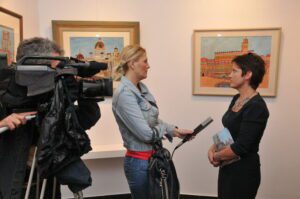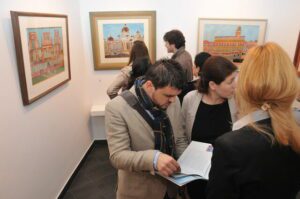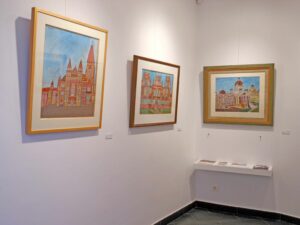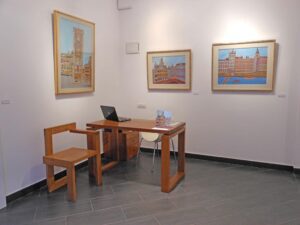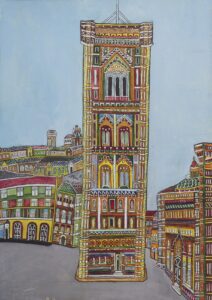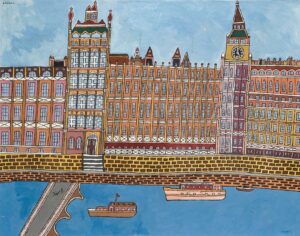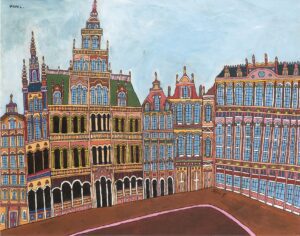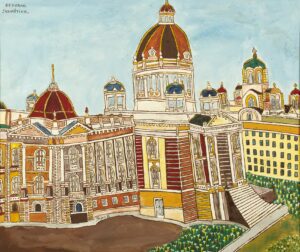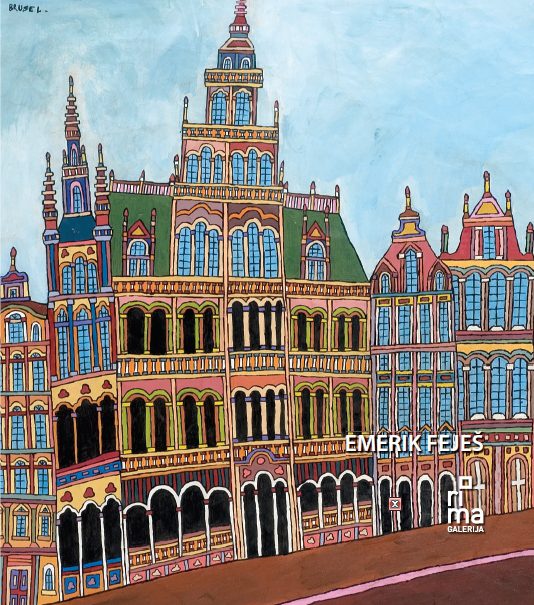By using the potential of his own intuition, his unconscious desire to maintain the identity, the vigour and singularity of his own experience, the naive artist fulfils in painting his need for a specific kind of self-expressiveness, of the poetic wish which turns him into an active creator. The source of singularity lies in his emotional position and not in his subjective intellectuality. The results of this instinctive pilgrimage are frequently high visual achievements attained despite the lack of professional education, indicating the force of his original contemplation. Although, at the time when our naive art appeared in the world, a great deal of the world art criticism ignored the existence of aesthetic quality in the works of these artists with a tendency to isolate them from the already renowned courses of art, naive and marginal art became the symbols of an art free from all the suppressions imposed by artistic conventions. In the meantime, after Rousseau there came a whole range of French naive artists, but also a series of artists from other parts of Europe, and among them are the instinctive neo-primitives from Serbia.
Nina Krstić
Emerik Feješ – the Builder of Imaginary Architecture
He began with nudes, portraits, still-lifes and genre scenes from the suburbia, but after 1954 he was almost exclusively engaged in townscapes. At his first solo show, held in the then Gallery of Primitive Art in Zagreb, 6 to 20 May 1956 – today it is the Croatian Museum of Naive Art – Emerik Feješ mounted forty-one works in tempera on paper, made between 1950 and 1956. It was, primarily a very brave beginning for the then anonymous man, with no professional training in art, but a man whose pictures disclosed a supreme artist „of a pure heart“ and brought a totally new reality into the representations of townscapes within the framework of our modernism. A series of experts wrote about him soon after his first several solo exhibitions (e.g. Mića Bašičević, Katarina Ambrozić, Mirjana Gvozdenović, Radoslav Putar, etc) and their texts meant his acknowledgement, the recognition of something personal, new, unusual and above all honest and inventive in the works of this artist.
In the 1950s the cultural and artistic life in Novi Sad would offer to Feješ new prospects and possibilities. He met there his contemporaries, painters, sculptors, authors, art historians: Oto Bihalji-Merin, Ivan Tabaković, Boško Petrović, Ana Bešlić, Bogomil Karlavaris, Ivo Frol, Grga Gamulin. Very soon they became his first buyers, offered him support and in a way helped him in his formative period when he was developing as a painter. For example, in 1952 Boško Petrović advised him to stop making „human faces“ and „still-lifes“ and turn his undivided attention to „buildings“; He sensed a great painter in those works.
Only a few years after his first exhibition, Feješ’s works went into the world. In 1958 he took part in the big world exhibition Les peintres naifs du Douanier Rousseau à nos jours, at Knokke-Le-Zoute, Brussels (29 June to 31 August, 1958). It was the first in a series of significant international shows where Feješ displayed his paintings together with the most important naive and other contemporary painters. Oto Bihalji-Merin was certainly the person who did the most to present Emerik Feješ’s works to the world. In 1959 he inserted reproductions of Feješ’s pictures into his renowned book Das naive Bild der Welt, and in that way classified him as one of the most important naive artists of the world. However, Feješ had weak health and suffered from melancholic bouts brought about by the conventional bleakness of urban surroundings; he was just a grain in a whirlpool, an anonymous, an insignificant screw under the grinding wheel. He desired to embellish the existing, to enliven the grey with colours; he was searching for his phantom of freedom by means of a creative network of lines into which he inserted the warm, resonant, fauvist strong colours.
The visual imagination of the artist needed a natural veil in order to protect him from the effects of grey reality. And therefore he painted mostly during the night. Daylight was too realistic. The moment of the unexpected, so frequently referred to by Jean Dubuffet, produces an unusual anxiety that can offer pleasure and conjure up images of totally unknown places. He „travelled“ through distant metropolises, and his brush would, like magic, obliterate dark and narrow walls turning them into high, light, lace-like façades of magnificent buildings. He would thus paint St. Mark’s Basilica in Venice, Big Ben in London, Notre Dame in Paris, St. Stephen’s Cathedral in Zagreb, Duomo in Milan, St. Stephen’s Cathedral in Vienna, buildings in Sienna, Florence, Budapest, squares in Basel, Belgrade, Brussels, Wales, Dubrovnik, Moscow, Novi Sad, Rome, Sarajevo, streets in Zagreb, Munich, Prague, Subotica, Stockholm, bridges in Basel, Lucerne, Ljubljana, canals in Amsterdam, Hamburg, Venice, Worms, Zadar, Trogir, buildings in America and India and many more famous or imaginary buildings, squares and urban wholes from around the world.
It seems at first sight that there were no significant changes in the continuity of his creative work. The paintings that represent magical architecture, more as a metaphor than real building, were those that made him famous because of showing his inventiveness. Therefore, all other, different pictures, his early vistas that could be defined as a creative quest for artistic self-awareness, were suppressed in the majority of exhibitions of his opus. Creative – because even as such, his early works indicated, like an overture, his expressiveness and a modern experience of form and motif. His representations of a dreamed reality introduce us into the world where the real and unreal are intertwined, anticipating a modern concept of artistic reality made from a harmony of the fantastic and concrete.
(Complete text in printed edition)
Artworks
- More about the artist


